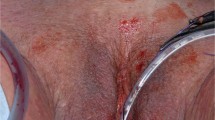Abstract
Study design:
Retrospective chart review.
Objectives:
To assess the outcome of minimally invasive treatment of stress urinary incontinence with alloplastic slings in patients with neurogenic lower urinary tract dysfunction.
Setting:
Switzerland.
Methods:
The patient database of a tertiary urologic referral center was screened for male patients with SCI who underwent implantation of a suburethral sling between June 2009 and December 2015. Patient characteristics and bladder management details were collected by chart review.
Results:
Sixteen patients were identified. Of those, 13 received a transobturator tape (TOT) and three underwent implantation of an retropubic adjustable system (RAS). In the TOT group, nine patients became continent, one patient was improved and three patients remained unchanged. Three patients underwent minor revisions due to impaired wound healing. In the RAS group, no patient improved and one RAS had to be removed due to severe wound infection; in a second patient, an abscess with destruction of the urethra occurred.
Conclusions:
In our experience, alloplastic slings seem to be an effective minimally invasive treatment option in male patients with SUI due to SCI. TOT seem to be more effective than RAS and was associated with less severe complications. The selection criteria for the optimal patient and the optimal sling have to be further defined.
Similar content being viewed by others
Log in or create a free account to read this content
Gain free access to this article, as well as selected content from this journal and more on nature.com
or
References
Gerridzen RG, Thijssen AM, Dehoux E . Risk factors for upper tract deterioration in chronic spinal cord injured patients. J Urol 1992; 147: 416–418.
Costa P, Perrouin-Verbe B, Colvez A, Didier J, Marquis P, Marrel A et al. Quality of life in spinal cord injury patients with urinary difficulties. Development and validation of qualiveen. Eur Urol 2001; 39: 107–113.
Patki P, Hamid R, Shah PJ, Craggs M . Long-term efficacy of AMS 800 artificial urinary spincter in male patients with urodynamic stress incontinence due to spinal cord lesion. Spinal Cord 2006; 44: 297–300.
Farag F, Koens M, Sievert KD, De Ridder D, Feitz W, Heesakkers J . Surgical treatment of neurogenic stress urinary incontinence: a systematic review of quality assessment and surgical outcomes. Neurourol Urodyn 2016; 35: 21–25.
Vainrib M, Reyblat P, Ginsberg D . Outcomes of male sling mesh kit placement in patients with neuropathic stress urinary incontinence: a single institution experience. Urol Int 2015; 95: 406–410.
Groen LA, Spinoit AF, Hoebeke P, Van Laecke E, De Troyer B, Everaert K . The AdVance male sling as a minimally invasive treatment for intrinsic sphincter deficiency in patients with neurogenic bladder sphincter dysfunction: a pilot study. Neurourol Urodyn 2012; 31: 1284–1287.
Lopez Pereira P, Somoza Ariba I, Martınez Urrutia MJ, Lobato Romero R, Jaureguizar Monroe E . Artificial urinary sphincter: 11-year experience in adolescents with congenital neuropathic bladder. Eur Urol 2006; 50: 1096–1101.
Gonzalez R, Merino FG, Vaughn M . Long-term results of the artificial urinary sphincter in male patients with neurogenic bladder. J Urol 1995; 154: 769–770.
Allison DJ, Ditor DS . Immune dysfunction and chronic inflammation following spinal cord injury. Spinal Cord 2015; 53: 14–18.
Myers JB, Mayer EN, Lenherr S, Neurogenic Bladder Research Group (NBRG.org). Management options for sphincteric deficiency in adults with neurogenic bladder. Transl Androl Urol 2016; 5: 145–157.
Bersch U, Göcking K, Pannek J . The artificial urinary sphincter in patients with spinal cord lesion: description of a modified technique and clinical results. Eur Urol 2009; 55: 687–693.
Yiou R, Loche CM, Lingombet O, Abbou C, Salomon L, de la Taille A et al. Evaluation of urinary symptoms in patients with post-prostatectomy urinary incontinence treated with the male sling TOMS. Neurourol Urodyn 2015; 34: 12–17.
Mascle L, Descazeaud A, Robert G, Bernhard JC, Bensadoun H, Ferrière JM et al. [Multicenter study of Advance suburethral sling for treatment of postoperative urinary incontinence of male]. Prog Urol 2015; 25: 249–255.
Athanasopoulos A, McGuire EJ . Efficacy of the bulbourethral autologous sling in treating male stress urinary incontinence: a three-year experience from a single center. Int Urol Nephrol 2010; 42: 921–927.
Mehnert U, Bastien L, Denys P, Cardot V, Even-Schneider A, Kocer S et al. Treatment of neurogenic stress urinary incontinence using an adjustable continence device: 4-year followup. J Urol 2012; 188: 2274–228.
Author information
Authors and Affiliations
Corresponding author
Ethics declarations
Competing interests
The authors declare no conflict of interest.
Rights and permissions
About this article
Cite this article
Pannek, J., Wöllner, J. Treatment of stress urinary incontinence in men with spinal cord injury: minimally invasive=minimally effective?. Spinal Cord 55, 739–742 (2017). https://doi.org/10.1038/sc.2017.16
Received:
Revised:
Accepted:
Published:
Issue date:
DOI: https://doi.org/10.1038/sc.2017.16
This article is cited by
-
Management of Neurogenic Stress Urinary Incontinence: An Updated Review
Current Bladder Dysfunction Reports (2024)
-
Deterioration of cystometric parameters following the artificial urinary sphincter procedure in patients with spinal cord lesion: a retrospective analysis
World Journal of Urology (2024)
-
Surgical management of the neurogenic bladder after spinal cord injury
World Journal of Urology (2018)
-
Use of Artificial Urinary Sphincter and Slings to Manage Neurogenic Bladder Following Spinal Cord Injury—Is It Safe?
Current Bladder Dysfunction Reports (2017)


